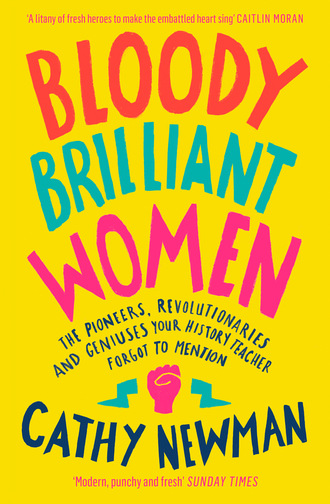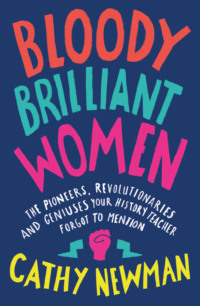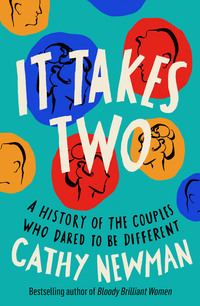
Полная версия
Bloody Brilliant Women
Christabel, meanwhile, had been drifting aimlessly, and in 1901 wrote to her mother: ‘Have you any ideas about me yet?’ She befriended two powerful, highly politicised women, Eva Gore-Booth and Esther Roper, both members of the North of England Society for Women’s Suffrage. They have sometimes been portrayed as a lesbian couple who drew Christabel into their relationship. The Pankhursts’ biographer Martin Pugh thinks this unlikely, but they had a warming, softening influence on Christabel. At Gore-Booth and Roper’s suggestion, she decided to study law. It would prove the perfect training for her quick, lively mind.
Emmeline seems to have been infuriated by Christabel’s political awakening. In 1903, perhaps jealous of Christabel for picking up the suffrage baton, she founded the Women’s Social and Political Union (WSPU), an extension of an earlier suffrage society she’d founded in 1889, the Women’s Franchise League. The WSPU motto, ‘deeds, not words’, underwrote their manifesto of what Ray Strachey calls ‘moral violence’, which was born of impatience with Fawcett’s slow attempt to obtain reform by constitutional means.
Emmeline sought a close relationship with the Independent Labour Party (ILP), but the ILP was ambivalent about female suffrage, fearing that if property-owning women got the vote as the WSPU demanded, they’d be more likely to vote Tory or Liberal. They also feared that allowing women to work would be bad for wages.
In 1905 the ILP leader Keir Hardie, to whom Sylvia had grown close, tried to introduce a bill proposing suffrage for female householders. His failure bolstered the Pankhursts’ confidence and they vowed to turn the WSPU into an ‘army in the field’, recruiting key personnel such as Hannah Mitchell, Flora Drummond – a stout Scot nicknamed Precocious Piglet who liked dressing in military uniform – and Annie Kenney. Annie had met Christabel in Oldham in spring 1906 and pledged allegiance on the spot. The fifth child in a family of eleven, she had left school at thirteen and was needy and damaged – a naive dreamer looking for a good, brave cause. Sylvia Pankhurst would later write that ‘her lack of perspective, her very intellectual limitations, lent her a certain directness of purpose when she became the instrument of a more powerful mind’.81
That powerful mind belonged to Christabel. For her, militancy was important because of the message it sent that women were capable of such behaviour. On 13 October 1905 she was arrested and imprisoned for deliberately spitting at a policeman outside Manchester’s Free Trade Hall, an event which turned the suffragettes, as the Daily Mail called them, into martyr-heroes.
After the Liberals won the 1906 election, Christabel severed her links with the ILP, and the WSPU moved to London, its goal to attract fashionable, bourgeois women and acquire both a funding stream and (with Keir Hardie’s help) a treasurer. A newspaper, Votes for Women, was launched and was selling 22,000 copies by May 1909. A car was bought for Emmeline and a chauffeur hired – former actress Vera Holme, who wore masculine attire and was always called Jack.
Artistic Sylvia, once a prize-winning student at Manchester School of Art and the Royal College of Art in London, oversaw the WSPU’s visual branding – the flags, banners and a broad range of ‘official’ memorabilia – while Emmeline Pethick-Lawrence, a wealthy philanthropist who was co-editor of Votes for Women, came up with the iconic colour scheme: purple (for dignity), white (for purity) and green (for hope). Members were encouraged to wear the colours ‘as a duty and a privilege’. Suffragette ‘uniforms’ were stocked by leading department stores like Selfridges and Liberty.
The WSPU fractured repeatedly over the next few years as new offshoots formed, such as the Women’s Freedom League. On 21 June 1908, a staggering 250,000 people attended a WSPU rally in Hyde Park, only for Asquith to dismiss its significance. Christabel was roused to violence once more and the suffragettes stormed Parliament Square in October 1908, after which Emmeline, Christabel and Flora Drummond were put on trial charged with incitement to rush the House of Commons. Lawyer Christabel scored another PR victory when she called Lloyd George and Gladstone in evidence and ran rings round them, controlling the courtroom ‘like a little singing bird’ (as the caricaturist Max Beerbohm put it). Jailed again, Christabel became a huge celebrity, and Madame Tussaud’s even commissioned her waxwork. But prison ground her down and the Liberal government, more distracted than ever by the effort of forcing through its radical programme under Lloyd George, continued to ignore female suffrage as an issue.
In the years leading up to the First World War, the WSPU continued to pursue its policy of seeking out violent conflict for propaganda purposes. When the suffragettes marched on Parliament again on 29 June 1909, Emmeline struck a policeman so that she would be arrested and tried for sedition. This ushered in a period of arson, chemical attacks and hunger strikes. The first imprisoned woman to refuse food was Marion Wallace Dunlop, who in July 1909 had been sentenced to a month in Holloway for vandalism. When she was denied political prisoner status, she refused food for ninety-one hours. Afraid that she would die and become a martyr, Gladstone released her early on medical grounds. This established a pattern other suffragettes would mimic – imprisonment followed by swift release. The government tried to break the pattern, first through barbaric methods of force-feeding (from September 1909), then later in April 1913 through the Prisoners (Temporary Discharge for Ill Health) Act, known as the Cat and Mouse Act. This enabled a hunger-striking prisoner to be released from prison when her health started to fail, then re-imprisoned when she had recovered so that her sentence could be served in full.
After 1910, Fawcett’s NUWSS became the main players as support for militancy crumbled. The WSPU had announced a cessation of hostilities in January 1910, but it didn’t last long. The eighteenth of November 1910 became known as Black Friday when Asquith’s quashing of the Conciliation Bill, which would have extended the vote to property-owning women, caused widespread protests. Around two hundred women were assaulted by police and the event gave rise to one of the suffrage campaign’s most famous photographic images: demonstrator Ada Wright lying on the ground, her hands covering her face while two men stoop over her.
By the end of 1911 there was still no real progress, despite Lloyd George being sympathetic to the cause. Asquith continued to voice his opinion that granting the vote to women would be a ‘political mistake of a very disastrous kind’. He simply didn’t understand why women would want to vote. After all, neither his wife nor his daughter did. He believed militancy – which he experienced personally when militants tried to tear off his clothes on the golf links at Lossiemouth in Scotland – was off-putting to the public and would kill popular support for the cause.
After the 1912 Reform Bill failed to give women the vote, Fawcett allied herself with the Labour Party, who agreed to vote against any future franchise bill that did not include women. The Pankhursts’ response was to go into furious overdrive – more window-smashing, more imprisonment, more force-feeding. Tiring of the melée, Christabel bailed out and moved to Paris, leaving Annie Kenney in charge. ‘Where is Christabel?’ asked the headlines. In fact, she had booked herself into a hotel under the name ‘Amy Richards’ and for a while continued to exert control remotely, for example issuing the order for the MP Lewis Harcourt’s house to be burned down. In practice, though, this was the beginning of her detachment from British politics. With Christabel out of the picture, Sylvia Pankhurst set up her own socialist-inclined suffrage campaign in the East End.
In January 1913 it looked as if women might win the vote at last, as the Franchise Bill was debated. But at the last minute the Speaker – Sir James Lowther, himself opposed to female suffrage – declared that any adoption of an amendment would so alter the bill that it would no longer be the same measure, so it would have to be cancelled and reintroduced in new form. The suffragettes took their anger out on Lloyd George, sending him sulphuric acid in the post and trying to burn down his country house.
The most notorious event in suffragette history was to follow: Emily Davison was trampled by the King’s horse at the Derby on 4 June 1913 and died four days later. The thinking now is that she was trying to attach a scarf to its bridle, not throw herself under it. Then again, as a devoutly Christian radical, she had on previous occasions been willing to damage her body for the cause. Over the course of seven hunger strikes, she was force-fed forty-nine times. At one stage her cell was deliberately flooded with ice-cold water.
On YouTube you can watch flickering footage of her funeral procession: a solemn, stately affair, though judging by the number of caps and straw boaters – removed out of respect as the cortège goes past – the crowds lining the streets contained far more men than we might expect.
But of course, many men supported female suffrage, not just as theorists (John Stuart Mill) and proud domestic cheerleaders (Millicent Garrett Fawcett’s blind husband, Henry) but as activists too. Frederick Pethick-Lawrence was imprisoned and force-fed alongside his wife, Emmeline, while George Lansbury MP, having resigned his seat to fight a by-election on the female suffrage issue, also found himself in a cell for defending the suffragettes’ arson campaign in a speech at a WSPU rally.
-------------------------------------
It’s somehow fitting that the best photos of the suffragettes were taken by a resourceful, enterprising woman. Christina Broom was a self-taught photographer who emerged as one of the key image-makers of the early twentieth century and is now celebrated as the first female press photographer. With her daughter Winnie helping, she would carry her heavy glass-plate camera onto the streets and photograph what she found – straightforward views of Tower Bridge or Oxford Street; royal events and sporting tournaments; Lyons tea boys brewing up at Victoria Station; the 1905 Earl’s Court Exhibition, with its makeshift Red Indian village – turning the resulting images into postcards which she, her disabled husband and Winnie printed up at home in Fulham and sold in their thousands. She also submitted her photographs to agencies for publication in newspapers and magazines.
Broom’s photos of the WSPU on parade take you beyond the Pankhurst family psychodrama, beyond the arid accounts of who did what to whom, and show you these extraordinary figures as they flit across the drab Edwardian landscape like exotic birds. Some of her finest ‘suffragette’ photos were taken on 23 July 1910 at a Hyde Park rally to celebrate the Conciliation Bill being debated, where over 150 campaigners were due to give speeches. Walking at the head of the ‘Prisoners’ Pageant’ are three formerly imprisoned suffragettes: Emmeline Pethick-Lawrence, Sylvia Pankhurst and, wearing her academic robes and looking stern, Emily Davison.
Christina stopped photographing the women’s suffrage movement in the summer of 1913. The following year, her health failing and increasingly confined to a wheelchair, she found a new subject: the military, especially soldiers before they left London for the Western Front.
Her photos of young men relaxing and on parade at their barracks are exceptionally moving – we know, as they do not, what fate has in store for them. But other more random pictures tell another parallel story. Among her First World War photos is a portrait taken in May 1916 that shows the direction of travel for women – a group of women police officers at a Women’s War Work exhibition in Knightsbridge. In their long black skirts, barely mustering a smile, they look austere and forbidding. At the centre, holding her gloves, staring down the camera as if she is about to arrest it, is a former suffragette called Mary Allen, now a police inspector …
An ambiguous, disturbing figure, Allen is the shape of things to come; a tidy emblem of the confusion many felt and would continue to feel as the twentieth century unwound; an example of what happens when a damaged personality grows convinced that the only meaningful solutions are extreme ones. But that is all in the future. For now, let us read the image as a celebration of female strength, solidarity and progress – a glorious summation of over thirty years of vigorous campaigning.
Конец ознакомительного фрагмента.
Текст предоставлен ООО «ЛитРес».
Прочитайте эту книгу целиком, купив полную легальную версию на ЛитРес.
Безопасно оплатить книгу можно банковской картой Visa, MasterCard, Maestro, со счета мобильного телефона, с платежного терминала, в салоне МТС или Связной, через PayPal, WebMoney, Яндекс.Деньги, QIWI Кошелек, бонусными картами или другим удобным Вам способом.



